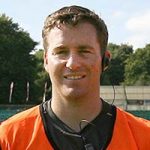Why it’s hard to stay active after competition ends

There are many reasons why people take up exercise including keeping fit, losing weight, relieving stress, along with the social aspect of being part of a group; or perhaps we have that competitive edge that allows us to test ourselves at our own level. Sometimes it can be difficult for the casual athlete to compare themselves to the elite competitor at professional or college level, because in terms of talent, commitment and sacrifice, they are a long way off that standard.
However, for anyone feeling a sense of inferiority, a report from Shawn C Sorenson offers a sense of reassurance that the casual athlete may fare better than the pro in at least one area by highlighting the idea they have a greater chance of continuing exercise in their later years. The demands of being a professional athlete can make it difficult to maintain exercise routine in retirement.
The findings of the research are outlined in Couch potato athletes: Why it’s hard to stay active after competition ends. It may sound surprising but the study reveals that many elite athletes have difficulty adapting to an exercise routine when their careers are finished. On the other hand, the leisure athlete has established a routine that fits in to their work and family life that is easily maintained. The study analyzed 500 students and alumni from the University of Southern California and included some who competed at the Olympics or went on to be pros — as well as non-athletes who never played college sports. Of the current students, it was no surprise that those involved in college sports averaged 15 hours per week exercise, while non-athletes averaged 4 hours. However, the analysis of former students from the 1980s and 90s illustrated that they were no more likely to be healthy exercisers than non-athletes. The researchers also found that this is a recent phenomenon and that athletes who had competed between the 1920s and 1965, were more likely to continue an exercise routine and therefore enjoy the health benefits that followed.
Difficulty in adjusting to new routine
It would appear that therein lies the reason why the modern day elite athlete finds it difficult to establish a new exercise pattern after retirement. It seems that the demands placed on the modern athlete in terms of discipline, intensity and structure, along with the motivation to succeed, makes it difficult for them to adapt. The report outlines this difficult by pointing out that:
From a young age, modern athletes become accustomed to executing a carefully planned training regimen under constant guidance and oversight. They are supported by an ever-growing infrastructure of coaches, trainers and support staff. College athletes might have a head coach, position coach, strength and conditioning coach, athletic trainer, physical therapist, dietitian, sports psychologist, and academic counselor assigned to them
The difficulty is that when his structure disappears, the athlete finds it difficult to apply themselves and this point is illustrated by Jennifer Lushao, a former Rice University swimmer.
You literally go overnight from being required to be somewhere doing strenuous, structured physical activity over 20 hours a week to having absolutely no obligations to do anything physical whatsoever. The freedom was really mind-blowing. Sleeping in instead of going to a workout at 6 a.m. for the first time since I was 11 was such a novelty
Another reason why athletes find it difficult to readjust is that the motivation for their training has been to succeed at the top level. When that goal is no longer there, they can often find it difficult to motivate themselves.
Athletes outline their struggles
The report points to examples of former athletes who have struggled with the transition from the professional ranks. Former pro footballer, Tim Conley, summed up the difficulty by stating:
For most former athletes the sole motivation to exercise is their sport. Once that is done, the motivation ends. It becomes, ‘What am I training for?’
It is a dilemma faced by former Rice hurdler Frank Miller Jr, who pointed out that:
My biggest challenge is exercising with no clear goal. Being healthy in general isn’t enough to motivate me. I need a ball to chase and a score of some kind. I get bored without a semi-immediate reward.
The problem of readjusting your mindset to pursue an exercise programme is highlighted by former Humboldt State University distance runner Adam Hall when he points out that:
I know how to start training again for a competitive race, but those aren’t necessarily the same things that I need to do to meet healthy guidelines.
How to overcome the problem
This phenomenon was experienced by Mark Kruchten, who outlined his difficulty in adjusting to life after completing his scholarship at Vanderbilt University in Nashville, Tennessee. In the The Former Athlete’s Guide to Staying in Shape he mentions that after college, although his intense training routine ended, his associated eating habits didn’t and as a result he gained 20lbs. As a result, he identified the need to develop an exercise program in order to remain fit and healthy, and he used his own experience to offer advice to others in the same situation.
- Restructure Physical Activity Into Daily Life
The best way to reintroduce physical activity into a busy schedule is by dedicating a specific hour each day to working out – the human body thrives on routine. The Centers for Disease Control and Prevention recommend adults get 150 minutes of moderate-intensity aerobic activity, such as swimming, biking or running, each week.
- Develop Specific Short-Term and Long-Term Goals
The desire for success is the motivation for elite athletes, but when a competitive career is finished it is important to find new motivations to maintain the new exercise routine by developing long-term and short-term goals.
- Work Out With a Friend
Leaving a team environment after retirement can make it difficult for an athlete to stick to a new exercise routine, therefore it is recommended to train with a friend to help with motivation and camaraderie.
Make Workouts Fun
Professional athletes can spend a lot of time following routines they do not necessarily enjoy, and this can put them off exercising after retirement. Therefore it is important to find activities that are fun and encourage them to maintain a new exercise program.
Please share this post so others may benefit.
About Metrifit
Metrifit is an athlete monitoring system that gathers subjective and objective information from both coaches and athletes to drive behavior modification and improvement through insights modeled on descriptive and predictive analytics. It sounds complicated but Metrifit prides itself on its simple intuitive interface and advocates a simple effective approach that doesn’t overwhelm the athlete or the coaching/staff member. It has received high praise for its intuitive interface and it allows monitoring to be scaled for all levels of athletes and teams. Recent research by Anna Saw (Deakin University, Australia) has shown that use of Metrifit is associated with increased athlete sporting self-confidence. Metrifit is ‘athlete-centric’ helping to develop self-awareness, encourage creative thinking and emotional intelligence as well as developing ownership and responsibility within the athlete for their own success.
Our base product is also very affordable retailing at $499 per year for up to 30 athletes and 5 coaches and is also available at monthly price of $44.99 with option of cancelling your subscription with 30 days notice.
To find out more information please visit Metrifit Overview or contact us at
References
Couch potato athletes: Why it’s hard to stay active after competition ends By Shawn C. Sorenson
The former athlete’s guide to staying in shape by Allison Underhill
Moving On: Staying Physically Active After College Sports by Dr. Erin Reifsteck
































 Previous Post
Previous Post Next Post
Next Post





